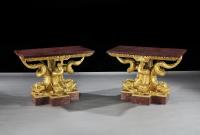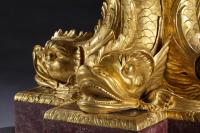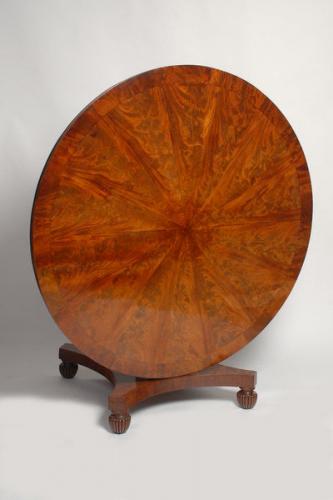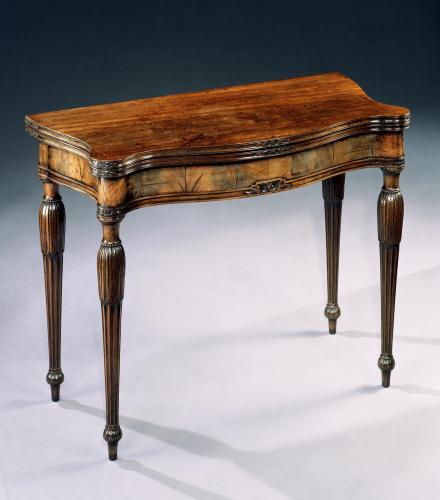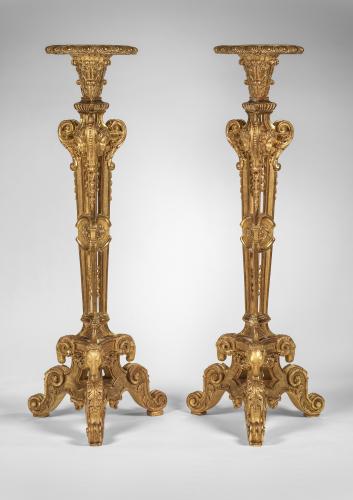




Price on application
This object is eligible for a Certificate of BADA Provenance
The BADA Standard
- Since 1918, BADA has been the leading association for the antiques and fine art trade
- Members are elected for their knowledge, integrity and quality of stock
- Our clients are protected by BADA’s code of conduct
- Our dealers’ membership is reviewed and renewed annually
- Bada.org is a non-profit site: clients deal directly with members and they pay no hidden fees
Each with a rectangular porphyry top above a frieze carved in relief with egg-and-dart above three scrolled dolphin supports, the simulated porphyry base carved with ribbon-and-floret borders.
Provenance:
From a set of at least 12 tables supplied to George Granvile Leveson-Gower, Marquess of Stafford and 1st Duke of Sutherland for Cleveland House, London, England.
Thence by descent with the Earls of Ellesmere, Bridgewater House (formerly known as Cleveland House).
Sold in a house sale in the 1950’s.
Literature:
John Cornforth, Mertoun-Berwickshire-II, Country Life magazine, 9 June 1966, fig. 3;
F. Herman, Collection Classics, The Connoisseur magazine, June 1966, p. 103;
C. Proudfoot, D. Watkin, The Furniture of C.H. Tatham-II, Country Life magazine, 8 June 1972, pp. 1481-1486;
D. Pearce, London Mansions, London 1986, fig. 135;
Christie's, John Harris, Treasures of the North, London 2000, p. 138, item 102;
T. Buckrell Pos, Tatham and Italy - Influences on English Neoclassical Design, Furniture History society journal, 2002, pp. 58-82;
Katherine S. Howe, Rienzi - European Decorative Arts and Paintings, Houston 2008, pp. 91-92, 203, 211;
Susan Weber, William Kent - Designing Georgian Britain, New York 2013, p. 604, fig.21.17.
This magnificent pair of giltwood side tables, part of a set of at least twelve, was supplied in circa 1803-6 to George Granville Leveson-Gower, Marquess of Stafford, later 1st Duke of Sutherland (d. 1833), for the ‘New Gallery’ at Cleveland House, St. James’s (later Bridgwater House) by Marsh & Tatham, cabinet-makers to George, Prince of Wales (d. 1830). The interlaced dolphin supports were almost certainly inspired from drawings by Charles Heathcote Tatham (d. 1842), which in turn derive from antiquity. John Cornforth notes that the frames were made to support some of the marble slabs which had been purchased in Italy in the 1750s by the Duke of Bridgwater for Ashridge, but remained in their packing cases (Cornforth, op. cit., pp. 1471-1472). The beauty of the marble, of various types and differing dimensions undoubtedly determined Lord Stafford to engage Marsh & Tatham to furnish appropriate ‘antique’ bases in which to display the magnificent 18th century Roman marbles slabs he had inherited.
The other tables from the set:
A pair of large tables (85 in. wide) with pink granite tops in the collection of the Duke of Sutherland at Mertoun, Berwickshire, illustrated in the ‘Inner Hall’ (J. Cornforth, ‘Mertoun, Berwickshire - II’, Country Life, 9 June 1966, p. 1471, fg. 3). Another pair (76 in. wide) with pink, grey and cream marble rectangular tops, now in an English private collection. A table (76 in. wide) acquired by the Worshipful Company of Fishmongers, London, 1960, from P.N. Hardiman of Royston, Herts. A pair of tables (56 in. wide) in the Museum of Fine Arts, Houston, The Rienzi Collection, gift of Mr. and Mrs. Harris Masterson III (94.1194.1,2). A pair (54o in. wide), purchased by Moss Harris in the house sale and acquired by British Oxygen, Bridgwater House; and subsequently sold anonymously, Christie’s, London, 4 July 1991, lot 161, £374,000 (with later white marble tops). A single small table, FitzWilliam Museum, Cambridge (on loan from a private collection).
Cleveland ( Bridgewater ) House:
Cleveland House was entirely rebuilt in a rigidly neo-classical style in the 1790s for Frances Egerton, 3rd and last Duke of Bridgewater (d. 1803). His nephew, Earl Gower, Marquis of Stafford, inherited the house, continued the restoration, and added to the remarkable picture collection acquired by his uncle, which included the Trumbull collection, and some of the spectacular Orléans collection, and he subsequently opened the house to the public. Part of the collection was housed in the specially commissioned ‘New Gallery’ or ‘Picture Gallery’ designed by C.H. Tatham in 1803-6 with a coffered ceiling inspired by the Temple of Venus. In 1818, the paintings were the subject of a scholarly four-volume catalogue edited by W.Y. Ottley, and two of the large tables from the set were illustrated in an engraved plan, and view of the gallery; the latter by J.C. Buckler dated 1808 (Herrmann, op. cit., p. 103, fgs. 2-3). In 1844, Mrs. Jameson described the decoration of this room in her Companion to the Most Celebrated Private Galleries of Art in London, ‘The picture gallery is not only the most magnificent room in London but is also excellently adapted to its purpose, in the management of the light, and the style of decoration. There is no colour but the dark rich crimson of the furniture, the walls being of a creamy white’ and undoubtedly referred to the two in situ giltwood tables, ‘the ornaments of dead and burnished gold’ (op. cit.). The gallery was subsequently redesigned by Sir Charles Barry (d. 1860), and rebuilt in 1846, for Lord Francis Egerton (created Earl of Ellesmere in 1846), who inherited Cleveland House on the death of Lord Stafford. At this time, the pair of large tables were moved to the central hall of the house where they were photographed in the late 19th century (Pearce, op. cit., p. 135).
Charles Heathcote Tatham:
C.H. Tatham’s inspiration for the interlaced dolphin supports of the present table, and the remaining set, almost certainly derives from antique marble fragments he illustrated in pen and ink drawings while on his Grand Tour from 1794-96. On his return, the drawings were published in Etchings of Ancient Ornamental Architecture drawn from the Originals in Rome, an important source book for neo-classical decoration and furniture based on the results of excavations at Pompeii, Herculaneum, Tivoli and Rome; the 1806 edition was dedicated to Lord Gower suggesting he was one of Tatham’s most important patrons in this period, and interestingly the date corresponds to when the set of tables was supplied by Marsh & Tatham. Tatham was fascinated by the dolphin motif as evident in the number of drawings and etchings he made; a pair of interlaced dolphins, a fragment from the cornice of the Temple of Neptune from the Orto Farnese, Rome, features in a drawing dated April 1795, now in the Victoria & Albert Museum collection (Buckrell Pos, op. cit., p. 68, fg. 7). Henry Holland, the Prince of Wales’s architect in the alterations of Carlton House and the Brighton Pavilion, employed and sponsored Tatham on his Italian tour to act as his agent in the purchase of antiquities and casts with which to furnish Carlton House, and to study and illustrate classical remains.
C.H. Tatham may also have been influenced by indigenous furniture of the early 18th century such as console tables with interlaced dolphin supports of the 1720s-30s in the ‘Kentian’ tradition of ‘Roman’ palace furniture (Weber, op. cit., p. 604). A similar but plainer giltwood console table with lacquer top, circa 1730, described as by William Kent, is illustrated in Country Life, 9 June 1966, p. 1477. Another with a marble top supported by interlaced dolphins, circa 1730, was formerly in the Ramsden Collection (illustrated Edwards, op. cit., p. 287, fg. 42).
The fashion for dolphin ornamentation underwent a revival in the early 19th century. Another celebrated suite of dolphin furniture was made by William Collins, and presented to Greenwich Hospital in 1813 by the widow of Mr. John Fish, in memory of Lord Nelson, now exhibited at the Brighton Pavilion (Jourdain, op. cit., p. 73, fg. 156). Further, a centre table with dolphin supports is illustrated in Ackermann’s Repository, vol. 8. Elward, Marsh & Tatham (the former name of the firm) also supplied a magnificent suite of seat-furniture in circa 1797-99 totaling £3000 for the Music Room, Powderham Castle, Devon that has closely related arm-supports in the form of dolphins.
Marsh and Tatham:
Marsh & Tatham were celebrated as ‘Upholders’ to George, Prince of Wales (later George IV) and additionally supplied furniture for Carlton House, London; they were also frequented by a number of significant aristocratic patrons. In 1795, William Marsh (f. 1774–85), who had supplied furniture for the Brighton Pavilion, and George Elward, were joined by Thomas Tatham (d. 1818), the elder brother of C.H. Tatham, and the firm became Elward, Marsh & Tatham (from 1803 known as Marsh & Tatham). The arrival of Thomas Tatham was significant for the firm because between 1795 and 1796, Henry Holland, the Prince of Wales’s architect, had lost through death or illness the assistance of three of his principal assistants, Jagger, Trécourt and Daguerre. Holland thus increasingly turned towards Elward, Marsh & Tatham for the refurbishment of Carlton House, Brighton Pavilion and Southill, Bedfordshire. C.H. Tatham, in addition to providing inspiration for furniture made by the firm through his neo-classical drawings, was also largely instrumental in gaining the firm commissions; bills in the Castle Howard archive show that C.H. Tatham engaged Marsh & Tatham there on at least two separate occasions, from September 1801 to July 1802 for work on the Gallery and Museum, and from 1811 to 1812 for work on the North Gallery and Octagon. The work was collaborative between designer and cabinet-maker, the latter supplied pelmets, cornices and curtains executed in gold with black scroll details, the anthemion at each corner of the pelmet was identical in form and ornament to Tatham’s drawing of an ‘antique ornament used upon the covers of urns, sarcophagi... perfect – of the finest sculpture in greek marble’ (Buckrell Pos, op. cit., p. 67). C.H. Tatham’s name also appears in a bill issued by Marsh & Tatham of 1806 for Carlton House, ‘To 4 elegant glass lusters made to Mr. Tatham’s
The Picture gallery and central Hall at Cleveland House
The BADA Standard
- Since 1918, BADA has been the leading association for the antiques and fine art trade
- Members are elected for their knowledge, integrity and quality of stock
- Our clients are protected by BADA’s code of conduct
- Our dealers’ membership is reviewed and renewed annually
- Bada.org is a non-profit site: clients deal directly with members and they pay no hidden fees


